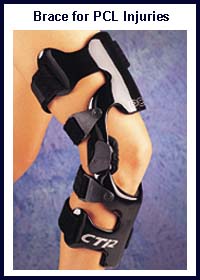In order to better understand how posterior cruciate ligament braces work it is important to understand basic knee anatomy and the function of the posterior cruciate ligament (PCL). Please review the sections on knee anatomy and on PCL injuries before reading this section.

PCL injuries are far less common than anterior cruciate ligament (ACL) injuries and thus more is known about the treatment of ACL injuries than the treatment of PCL injuries. The same can be said about ACL and PCL braces. ACL braces seem to help people with ACL injuries but the biomechanics of the ACL is different than the PCL and PCL braces may not be as effective as ACL braces.
What is a posterior cruciate ligament (PCL) brace?
The PCL helps stabilize the knee by preventing excessive backward movement of the shin bone (tibia) on the thigh bone (femur). PCL injuries can go undetected because unlike anterior cruciate ligament (ACL) injuries they are less likely to cause problems with instability. However, if the PCL is significantly damaged or if other knee ligaments are damaged in addition to the PCL the knee can feel “unstable”.
Depending upon the type and severity of the injury, other structures in the knee may be damaged in addition to the PCL. There may be injuries to the “shock-absorbing” cartilage (menisci), the collateral ligaments (MCL or LCL), the ACL or the bones of the knee. The degree of injury to the PCL may vary. In some cases, the PCL may only be partially torn or in more serious cases the PCL may be completely torn. Unfortunately, the PCL does not have the ability to completely heal once it is injured.
After a PCL injury, the long term goal is to return the individual back to their previous level of activity. A general knee rehabilitation program which includes strengthening exercises, flexibility exercises, aerobic conditioning, technique refinement and proprioceptive (biofeedback) retraining is the most important factor in achieving this goal. Some people with PCL injuries report an improved sense of stability when wearing a PCL brace, particularly if they have had an injury to another knee ligament.
PCL braces have a light-weight frame and hinges at the knee joint. Straps help secure the brace to the knee. Most PCL braces have a pad or a strap that keeps the tibia forward on the femur. This type of construction allows the knee to bend and straighten while providing forward-backward (anterior-posterior) and rotational support to the knee. PCL braces also provide support to the inner (medial) and outer (lateral) aspects of the knee. An injured knee can be fit with an “off the shelf” brace or a custom fit brace. The type of brace depends on the size and shape of the individuals’ leg.
How does a PCL brace help?
PCL braces are designed to reduce knee instability following an injury to the PCL, particularly if other ligaments have been damaged.. They are usually recommended for twisting, pivoting, cutting or jumping activities. In addition to providing increased stability to the knee, PCL braces may also decrease the risk of injuring other parts of the knee.
What is bad about a PCL brace?
PCL braces have some drawbacks. Some people report that they are heavy, hot and cumbersome. PCL braces can also be expensive. Furthermore, PCL braces do not always work. Sometimes they do not improve the stability of a PCL injured knee especially when the knee is very unstable or there are other significant ligament injuries to the knee. PCL braces do not return normal stability to the knee, so the knee may still feel unstable under high forces. However, when PCL braces are fitted properly and when used in conjunction with a general knee rehabilitation program PCL braces can serve a role in the treatment of PCL injuries to the knee.
How do I know if I need a PCL brace?
Doctors and physiotherapists who treat PCL injuries can advise whether a brace would be helpful and how to get the brace. PCL braces should be considered as part of the treatment of PCL injuries of the knee. Doctors and physiotherapists who are skilled in treating PCL injuries can advise whether a brace would be helpful and where and how to get the correct brace.
Please visit the links section for additional information on PCL braces. Links have been provided to other websites as well as online medical journals. Other knee injury topics can also be accessed.
